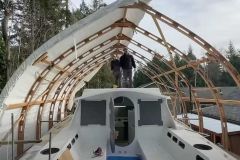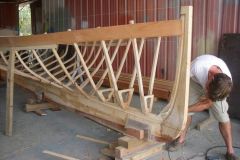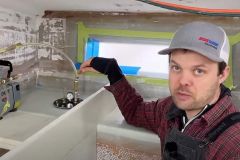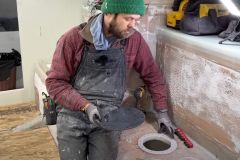Glazing cut-out and choice of material
In the previous episode, Matt made frames for the future hull portholes designed to bring light into the new cruising accommodation on his Duracell sailboat. Now it's time to laminate them from the outside, and before that, sand the contours to remove paint, gelcoat and the first layers of fiberglass. To avoid damaging the corners, Matt inserts a sacrificial shim into the recess created by the frame.
Once the hole has been cut, from the inside so that he can use the guide on his router, it's time to look at the glazing material. For the time being, Matt is going to install temporary Plexiglas panels salvaged from the original companionway panel, but he's wondering about the respective advantages of polycarbonate, Plexiglas and glass for the final glazing.
A new delphinière design
In today's 2nd episode, at the foot of the article, Matt looks back at the design of his delphinière, with comments from his community. A new mannequin is presented, with a few modifications. Taller, wider and with a double gusset at its base, it should be more robust and thus tolerate a larger opening for the anchor. As a result, the anchor is higher above the water. An angle on the chain avoids code 0 chainplates and staysail to reach the windlass.
Once the choices have been made, Matt can prepare the area by repairing the old bowsprit sub-beam attachment, which is now useless. He then prepares the areas for the staysail, genoa and code 0 chainplates, adapting to the discoveries made when attempting to cut the material.








